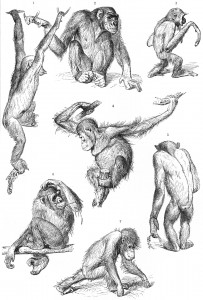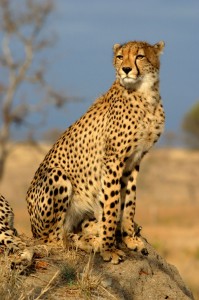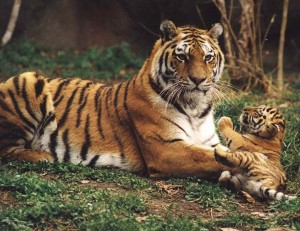Contemporary artworks in museums are like animals in zoos. (Those artworks still in the “wild” and roaming free are in private collections.) In this way, caring for some contemporary artworks requires that we consider the artwork’s needs, environment, and its future. Think of performance-based works, site-specific installations, ephemeral and interactive works, and all of the projects that have elements with built-in variability, ongoing maintenance needs, and components that need to be replaced or refreshed.
Here to help explore this analogy from a zoological conservation perspective is Norah Fletchall, the Vice President of Conservation at the Indianapolis Zoo. Norah came to the Indianapolis Zoo in 2009 from the John Ball Zoological Garden in Grand Rapids, MI, where she served as Deputy Director. She started her zoo career at the Saint Louis Zoo, where she was a zookeeper. With an undergraduate degree in animal science and a MBA, Norah is an active Professional Fellow with the Association of Zoos and Aquariums (AZA) and a founding member of the Thailand Clouded Leopard Consortium.
Richard McCoy: Will you describe your role and responsibilities as a conservator at the Indianapolis Zoo?
Nora Fletchall: Connecting our visitors and our community to wildlife and moving them towards support of our efforts to preserve and restore our planet’s biodiversity is my primary role at the Indianapolis Zoo. We strive to engage our guests to care about wildlife through effective and powerful exhibits while at the same time providing them with opportunities to support conservation of animal species in the wild.
Zoos and aquariums contribute to conservation of animals in the wild through support of conservation biologists such as those honored by the Indianapolis Prize; ongoing research on the biology of animals living in the wild and through education of people living in areas where wildlife and humans are in conflict. This education is designed to help them discover ways that reduce that conflict.
RM: Many art conservators are moving towards a team approach when it comes to caring for contemporary artworks (I’ve talked about this team approach on this blog here and here). I know the Indianapolis Zoo works as a team to care for its animals. Will you talk about the specific roles zoo staff take on while caring for animals and how they work as a team?
NF: Providing high quality animal care is one of the foundations of what we do at the Indianapolis Zoo. Our animal collections team works tirelessly to provide excellent care for our living collection. Zookeepers are charged with the daily care of the animals and this involves not only cleaning and feeding the animals but also making sure that the animal’s lives are enriched. Zookeepers provide this enrichment daily to our animals through a variety of methods depending upon the species.
For primates, enrichment might be done via providing food in ways that encourages foraging. For other animals like cats, that enrichment might be items that stimulate their desire to chase or hunt. Zookeepers work continually to assure each animal under their care has not only its physical needs met but also its psychological needs.
Our curatorial staff oversees animal care and works closely with other zoos to assure that our collection is genetically diverse and sustainable. Veterinarians implement and oversee the health of our animal collection while those of us in the education department strive to provide opportunities for our audiences to understand and appreciate wildlife and wild places.
RM: Clearly zoos must provide a place for animals to live healthy and happy lives, while also providing a way for visitors to witness them up close. Similarly, at museums we’re always looking for different exhibition approaches to representing and protect artworks while on display. With this in mind, will you talk about the thought process that goes into creating a zoo exhibition?
NF: Every new exhibit at a zoo should begin with developing the “message” that we want the visitors to understand or embrace when they experience the exhibit. Sometimes we already have the animal in mind so the message arises with the animal as the foundation. Other times, the message is formulated first and the animals determined later. Once animals and the message are in place, the exhibit design process begins in earnest.
Zoo exhibit design is a very iterative process. You have to balance the animals’ needs and adaptations with the visitor’s needs. Designing spaces that provide as much opportunity as possible for the animals to exhibit their natural behaviors, while maximizing visitors’ ability to see them, is challenging. From the visitor’s perspective, we look for experiences at exhibits that connect guests with animals either through an up-close experience or through a story.
Our newest exhibit, Cheetah: the Race for Survival, opens Memorial Day weekend. In this exhibit, visitors will have the opportunity to not only see and learn about cheetahs but see if they can run faster than a cheetah. Proceeds from our Race a Cheetah experience with go directly to support cheetah conservation in the wild.
RM: In museums, one of the things we do for exhibitions is loan artworks around the world. This takes a lot of time, care, effort, and resources. I know that zoos also often share animals. Will you talk about some of the challenges involved in loaning a tiger or a giraffe, for example?
NF: Those zoos, like the Indianapolis Zoo, accredited by the Association of Zoos and Aquariums (AZA), work cooperatively to assure that the population of species you see in zoos is genetically diverse and sustainable over time. This is done through cooperative management programs such as Species Survival Plans® (SSPs). For each specific species, zoos agree to move animals around to provide opportunities to breed and produce offspring.
As there is only a certain amount of space in zoos, we need to be careful in our breeding plans to assure that one particular genetic line is not over- or under-represented. Transfers of animals to accommodate breeding, social, or exhibit needs based upon these SSP recommendations are done cooperatively. Most of the time, animals are not sold to other zoos but are loaned or donated to the receiving zoo. Managing this process to assure genetic diversity is a challenge.
Accurate recordkeeping is crucial and is done through something called a Studbook, which is a listing of all the animals of a species found in a zoo. This listing is historic as well as current, and facilitates the accurate tracking of genetics and demographics of a population. Studbook keepers utilize an software system that designates each specific animal with a number. That number stays with that animal its entire life.
RM: Will you give an example of how the Indianapolis Zoo is currently using a Studbook?
NF: Many of you may remember that some years ago the Indianapolis Zoo received a female tiger that had been orphaned in the wild in Russia (here’s a link to the 1997 New Yorker article). This female went on to produce cubs whose genes are extremely valuable to maintaining the diversity of tigers in zoos. So through the tiger Studbook, we can track where her offspring went, if they produced offspring, and where those animals are now.
Keeping track of these tigers over time is very important to making sure that the tigers you see in zoos in the future continue to be from the genetic reservoir necessary to assure a stable, healthy population of zoo tigers.
RM: In the same way that the IUCN has created the Red List of Threatened Species, it occurs to me that a lot of artworks these days could be considered “endangered.” I’m thinking of all of the artworks that rely on technological components such as CRT televisions, 16mm film projectors, and materials that have rapid degradation systems (plastics, for example). Maybe art museums could take a lesson from IUCN and zoos and create something like a Studbook for endangered artworks that are time-based. I’m imagining a global Studbook for Nam June Paik artworks that would describe what their current condition is and who the experts are at maintaining them. In this way, we could assure that they are represented correctly. However, I realize that one of the reasons zoos are interested in working together and sharing information is you’re your work is literally a matter of life and death for animals. Will you talk about some of the other challenges you’re currently facing?
NF: One of the biggest challenges we face is the constant impact of humans on our environment and, in turn, on wildlife. The Earth’s regenerative capacity can no longer keep up with demand as people are turning resources into waste faster than nature can turn waste back into resources.
The role that the Zoo plays in this challenge is interesting. Operation of a multi-million dollar facility designed to provide a pleasant, enriching environment for the animals under our care and the guests that visit the zoo requires large amounts of resources. Many of these resources are expensive and some are non-renewable.
Audiences relate most effectively to complex issues such as climate change and loss of biodiversity. When they develop a caring attitude, they relate to the issue on a personal level and immediately take positive actions to affect change.
The Indianapolis Zoo strives to be the lens through which our audiences see the positive results of sustainable behavior and embrace that behavior in their own lives. The Zoo has made great strides in this area over the last few years through our recycling and water conservation efforts. We recycle all of our paper, corrugated cardboard, aluminum, newspaper, and mulch. We use landscape and tree trimmings as enrichment for some of our animals. In 2008, we recycled 6.5 tons of paper, over 4 tons of glass, aluminum cans and plastic, 65 pounds of batteries, 482 pallets, 520 yards of wood, 200 yards of garden waste, 524 cell phones, and 24 tons of cardboard.
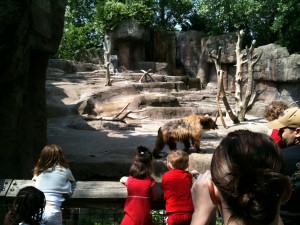
Alaskan bear at the Indianapolis Zoo. Photo: Richard McCoy
RM: I imagine there are a lot of people that don’t realize that the Indianapolis Zoo is accredited by both the Association of Zoos & Aquariums and the American Association of Museums. In comparing the mission statement of the Indianapolis Zoo with the Indianapolis Museum of Art’s, it becomes clear that both are interested in caring for cultural heritage, providing visitors an authentic experience, and that aesthetics are of great importance. With this in mind, will you talk about the difference between how visitors perceive an animal and how it behaves when it’s happy and healthy?
NF: Many times, our perceptions of animals, particularly exotic animals, are based upon what we might have seen on TV or at the movies. Determining if an animal is happy and healthy relies upon understanding that animal’s biology and behavior. Zoos work very hard at understanding that behavior and biology and then providing for that need.
Lions are one example. Lions sleep about 20 hours a day in the wild and when they do hunt, females do the majority of the work. So when you visit the zoo and see a lion sleeping she’s doing what comes naturally!
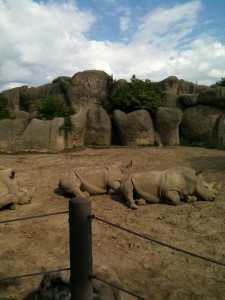
Southern white rhinos Spike, Mambo, and Gloria taking a morning nap at the Indianapolis Zoo. Photo: Richard McCoy


